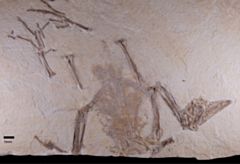Project 4001: G. Musser, J. A. Clarke. 2024. A new Paleogene fossil and a new dataset for waterfowl (Aves: Anseriformes) clarify phylogeny, ecological evolution, and avian evolution at the K-Pg Boundary. PLOS ONE. 19 (7):e0278737.

Specimen: † Paakniwatavis grandei Grace Musser, Julia A. Clarke, 2022 (FMNH/PA:725)
View: top
View: top
Abstract
Despite making up one of the most ecologically diverse groups of living birds, comprising soaring, diving and giant flightless taxa, the evolutionary relationships and ecological evolution of Anseriformes (waterfowl) remain unresolved. Although Anseriformes have a comparatively rich, global Cretaceous and Paleogene fossil record, morphological datasets for this group that include extinct taxa report conflicting relationships for all known extinct taxa. Correct placement of extinct taxa is necessary to understand whether ancestral anseriform feeding ecology was more terrestrial or one of a set of diverse aquatic ecologies and to better understand avian evolution around the K-T boundary. Here, we present a new morphological dataset for Anseriformes that includes more extant and extinct taxa than any previous anseriform-focused dataset and describe a new anseriform species from the early Eocene Green River Formation of North America. The new taxon has a mediolaterally narrow bill which is rarely found in previously described anseriform fossils. The matrix created to assess the placement of this taxon comprises 41 taxa and 719 discrete morphological characters describing skeletal morphology, musculature, syringeal morphology, ecology, and behavior. We additionally combine the morphological dataset with published sequences using Bayesian methods and perform ancestral state reconstruction for select morphological, ecological and behavioral characters. We recover the new Eocene taxon as the sister taxon to (Anseranatidae+Anatidae) across all analyses, and find that the new taxon represents a novel ecology within known Anseriformes and the Green River taxa. Results provide insight into avian evolution during and following the K-Pg mass extinction and indicate that Anseriformes were likely ancestrally aquatic herbivores with rhamphothecal lamellae.Read the article »
Article DOI: 10.1371/journal.pone.0278737
Project DOI: 10.7934/P4001, http://dx.doi.org/10.7934/P4001
| This project contains |
|---|
Download Project SDD File |
Currently Viewing:
MorphoBank Project 4001
MorphoBank Project 4001
- Creation Date:
13 May 2021 - Publication Date:
16 May 2024
This research
supported by
Authors' Institutions ![]()
- National Museum of Natural History, Smithsonian Institution
- University of Texas at Austin
Members
| member name | taxa |
specimens |
media | media notes |
| Grace Musser Project Administrator | 1 | 1 | 1 | 0 |
Project has no matrices defined.
Project downloads 
| type | number of downloads | Individual items downloaded (where applicable) |
| Total downloads from project | 26 | |
| Project downloads | 16 | |
| Document downloads | 10 | Appendix (3 downloads); Trees from analyses including Anachronornis, Perplexicervix and Danielsavis (1 download); Morphology Only Matrix (2 downloads); Combined Data Matrix with all taxa included (2 downloads); Morphology only Matrix including Perplexicervix, Anachronornis, and Danelsavis (2 downloads); |
